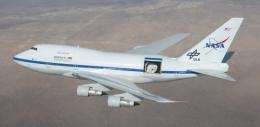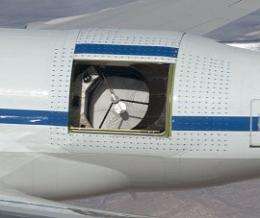Flying Telescope Passes Key Test

Most astronomers wouldn't dream of opening their observatory's doors in 100 mph winds. Yet NASA's new SOFIA telescope recently flew in an airplane at 250 mph with doors wide open.
On Dec. 18th, the Stratospheric Observatory for Infrared Astronomy (SOFIA), flew in a modified Boeing 747 at 15,000 feet for one hour and 19 minutes. For two minutes of that time, the door by the telescope was wide open.
"This was the first time the door was fully opened in flight," says Bob Meyer, SOFIA program manager at the Dryden Flight Research Center. "We wanted to find out whether opening the door affected flying and handling the aircraft, caused acoustic resonance in the cavity, or made anything come loose in the cavity because of wind."
"When you blow air over a soda pop bottle and hear a hum, that's acoustic resonance. If that happened in the plane, it could vibrate the structure of the plane and the telescope and cause problems."
SOFIA passed with flying colors. "Everything went well. No adjustments or corrections were needed. Nothing shook loose or got damaged."
The 98-inch infrared telescope is ultimately destined to fly at 40,000 feet and study a range of astronomical objects over its expected 20-year lifetime. Those objects include other galaxies and the center of our own Milky Way Galaxy; the interstellar medium, especially the building blocks of life it contains; the formation of stars and planets; and comets and asteroids in our solar system.
The veil of water vapor enveloping Earth acts like an invisible brick wall to the infrared energy from cosmic objects SOFIA wants to see. SOFIA solves this problem by viewing the heavens from "above the veil" - something ground-based scopes can't do. Like space-based telescopes, SOFIA will collect infrared energy before it reaches Earth.
It will do so while looking through the open door of its aircraft. As in the test, the telescope, with its primary, secondary, and tertiary mirrors, will sit in a cavity in the rear of the plane. The telescope's controls, computers, spectrometers, and other instruments will ride in the pressurized cabin. The scientists, also in the cabin, can look through a physical window in the cabin wall to view the actual image the telescope takes. The image is transmitted through a tube (called a nasmyth tube) attached to the window on one end and the telescope on the other.

More testing is planned for the spring of 2010 before SOFIA can begin science operations in the fall.
"We'll test at all the speeds the plane can fly and all the altitudes planned for the mission," says Meyer. "We'll also test different pointing elevations of the telescope itself."
"Our first light test, where we actually look at an image and characterize the telescope, is set for April. In that test we'll unlock and uncage the telescope so it will move as though it's really observing. The wind will be buffeting and shaking SOFIA, so that will be the first true test of its ability to obtain stable images."
How do you keep a telescope still enough to point accurately and stay "on point" in a moving airplane with the door open?
"The telescope rests on big shock mounts that isolate the mechanical vibrations of the plane from it. And on the back edge of the cavity there's a ramp that catches the airflow entering the cavity and redirects it back over the ramp and out of the cavity."
SOFIA will also have weights attached to it that can be sized and tuned to dampen any shaking. And the drive system can move the scope back and forth to compensate for lower frequency vibrations or movement of the aircraft. The secondary mirror can even be oscillated to take out the shaking of the image itself.
"SOFIA is really a marvelous piece of engineering," he concludes. "This flight test represents a huge success and significant milestone for all the people who have worked hard for a decade on this mission."
Source: Science@NASA, by Dauna Coulter




















